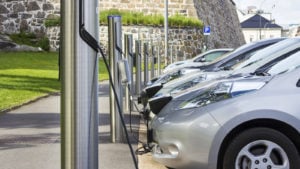While the risk-averse investor is unlikely to want to explore EV startups to invest in 2024, those with a bit of a risk tolerance — or invested in Tesla (NASDAQ:TSLA) in the early days — might be interested in turning over some stones in search of the next great innovator.
Heading into 2023, EV magazine highlighted 10 EV startups to watch. Several of the names on their list crashed and burned last year. While it doesn’t seem to have made a list for 2024, it does have one for the top 10 EV tech companies. Perhaps I can find a startup or two from this list.
Regardless, I’m tasked with identifying three publicly traded EV startups ready to revolutionize in 2024. Here are my three choices.
NWTN (NWTN)

NWTN (NASDAQ:NWTN) is the largest of the three EV startups on my list. It has a market capitalization of $1.7 billion.
A business of this size should have a better investor relations website outlining the investment opportunity. Sadly, it doesn’t provide much other than superlatives about its capabilities.
Despite this significant shortcoming, I’m willing to keep an open mind, so I’ve pulled up the 20-F for some background. If you can’t tell, this is my first time covering NWTN. It might be my last.
Based in Dubai, United Arab Emirates, it is a “Smart Passenger Vehicle” company developing a portfolio of EVs, including the Rabdan Muse, which appeared at COP28, the United Nations Climate Change Conference this past December.
The company’s first production vehicle is the Rabdan One, an attractive electric SUV built in NWTN’s Abu Dhabi assembly facility. The company was officially recognized as “Made in the Emirates” last October.
NWTN went public by merging with the East Stone Acquisition Corporation SPAC (special purpose acquisition company) in November 2022. Its shares have lost nearly half their value in the 15 months since going public.
In the six months ended June 30, 2023, NWTN had an operating loss of $48.3 million on $583,000 in revenue.
NWTN is what you’d call an EV startup. It’s for aggressive investors only.
Lion Electric (LEV)

Lion Electric (NYSE:LEV) is the second-largest of the three EV startups. It has a market capitalization of $380 million.
The Quebec-based company manufactures six electric vehicles: the LionC and LionD school buses, which began deliveries at the end of January, and the Lion5, Lion6, Lion8, and Lion8 Tractor.
In the nine months ended Sept. 30, 2023, it sold 664 units (593 school buses and 71 trucks), up from 345 in the same period in 2022. Of the 664, the company sold 518 in Canada and 146 in the U.S.
The revenue on those sales amounted to $193.1 million, 107% higher than a year earlier, with an operating loss of $51.4 million, down from $60.4 million in 2022’s first nine months.
On Jan. 10, Lion announced it was awarded a $38 million grant for delivering 97 school buses as part of the EPA’s (Environmental Protection Agency) Clean School Bus Program.
Unfortunately, the company was forced to lay off 10% (150 employees) of its workforce in November to rightsize its business for future profitability. It is a short-term pain for longer-term gain.
Xos (XOS)

Xos (NASDAQ:XOS) is the smallest of the three EV startups. It has a market capitalization of $52 million.
The Los Angeles-based company was founded in 2016 by truck fleet operators Dakota Semler and Giordano Sordoni. They were looking to find a lower TCO (total cost of ownership) for their truck fleets.
It started with EV stepvans in 2018, delivering vehicles to UPS and Loomis a year later, and in 2021, it delivered 44 stepvans while also going public in August of that year through a SPAC combination. At the time of the IPO, it had a 6,000-unit backlog.
At the time of the SPAC combination in February 2021, the merged entity’s equity was valued at $2 billion. That’s certainly not the case today.
Where is it today? Business is healthy and moving in the right direction.
In November, it reported Q3 2023 results, including the delivery of 105 units, 176% higher than Q3 2022, and $16.7 million in revenue, almost 4x higher. For 2023, it expects between 250 and 350 units to be delivered to customers.
As of the end of September, it was at 174, so it may deliver 100+ for a second consecutive quarter, with annual revenue of at least $36.3 million and a $50.5 million loss.
XOS is an exciting play, but there’s no question it’s the riskiest of the three stocks.
On the date of publication, Will Ashworth did not have (either directly or indirectly) any positions in the securities mentioned in this article. The opinions expressed in this article are those of the writer, subject to the InvestorPlace.com Publishing Guidelines.
Will Ashworth has written about investments full-time since 2008. Publications where he’s appeared include InvestorPlace, The Motley Fool Canada, Investopedia, Kiplinger, and several others in both the U.S. and Canada. He particularly enjoys creating model portfolios that stand the test of time. He lives in Halifax, Nova Scotia.
